We know them well, the several scores of buildings that adorn Denison’s campus. Naturally, some of us harbor more intimate knowledge of certain structures than others. We’ve held forth with professors in their classrooms and of?ces, analyzed in their laboratories, created in their studios, sought quiet study time in their corners, yelled to friends from their windows, indulged in ?ne (ahem) dining at their tables, snuggled in the warmth of their beds, or watched the dawn break over their rooftops after another sleepless eve of scholarly fret or social frolic. We know well those edi?ces we’ve passed beneath on countless cross-campus treks. And we know the names inscribed at their front doors. But what do we know of the people who ?rst bore those names? Doubtlessly, they played some signi?cant role in the 175-year history of the college and, one could presume, life beyond the hill. Let us now test that knowledge with a walk across campus, and back through time.
The People
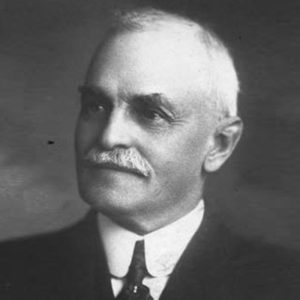 A Like many of Denison’s early benefactors, this Dayton trustee (1900-1936) had little formal schooling. He started his career delivering the laundry taken in by his mother, and later in his life achieved success in the soap business, as co-founder of a company with a name worth mentioning. He donated an elegant new womens’ residence hall to honor his wife in 1925.
A Like many of Denison’s early benefactors, this Dayton trustee (1900-1936) had little formal schooling. He started his career delivering the laundry taken in by his mother, and later in his life achieved success in the soap business, as co-founder of a company with a name worth mentioning. He donated an elegant new womens’ residence hall to honor his wife in 1925.
 B The East Quad is currently home to a thousand or so good-looking and studious undergraduates. Prior to 1917, it was the bucolic family farm of a much-beloved professor of mathematics, whose name is still familiar and whose home, although uprooted, is still in use. Who was this mathematician, and where did his house once stand?
B The East Quad is currently home to a thousand or so good-looking and studious undergraduates. Prior to 1917, it was the bucolic family farm of a much-beloved professor of mathematics, whose name is still familiar and whose home, although uprooted, is still in use. Who was this mathematician, and where did his house once stand?
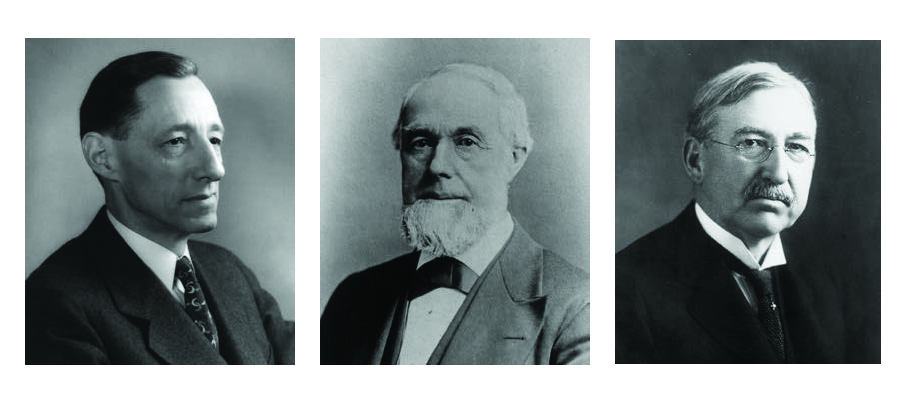
C The college payed tribute to three generations of Denison trustees—whose combined service at that time spanned more than half of the college’s existence—with the 1960 dedication of what building? Hint: it completed what was then known as the Women’s Quad.
The Places
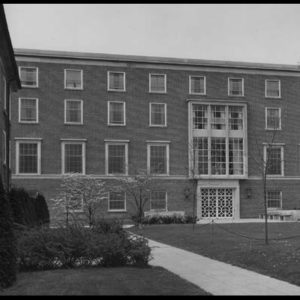 1 Huffman Hall pays tribute to three generations of Denison trustees dating back to 1864, when William Phillips Huffman began a 24-year term of service. His son, Torrence, attended Denison University in 1872 and 1873 and later served as a trustee from 1899 until 1927. Torrence’s son, William P. Huffman ‘11, was appointed to the Board of Trustees in 1939. A native of Dayton, Ohio, he was president of the Buckeye Iron and Brass Works in Dayton and remained active in the national councils of Sigma Chi, his fraternity at Denison. He served as chairman of the Board of Trustees from 1950-56 and completed his service in 1973.
1 Huffman Hall pays tribute to three generations of Denison trustees dating back to 1864, when William Phillips Huffman began a 24-year term of service. His son, Torrence, attended Denison University in 1872 and 1873 and later served as a trustee from 1899 until 1927. Torrence’s son, William P. Huffman ‘11, was appointed to the Board of Trustees in 1939. A native of Dayton, Ohio, he was president of the Buckeye Iron and Brass Works in Dayton and remained active in the national councils of Sigma Chi, his fraternity at Denison. He served as chairman of the Board of Trustees from 1950-56 and completed his service in 1973.
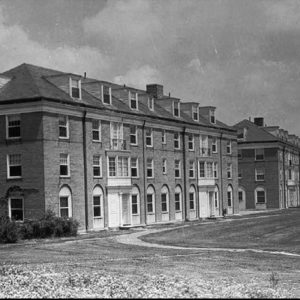
2 Frederick Philips Beaver, co-founder of the soap producer Beaver & Butt Manufacturing, was by all accounts eager and busy, and much admired for his hard work and generosity. His wife, Mary Thresher Beaver, was the daughter of Ebenezer Thresher, another generous friend to Denison and an industrialist who founded an early railroad car manufacturing plant, The Barney & Smith Car Co., with Eliam Barney (after whom Barney-Davis Hall is named).
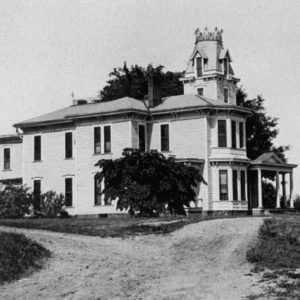
3 John L. Gilpatrick built his Victorian Italianate style house in 1 875, the year after he came to Granville as one of Denison’s ten instructors. Prof. Gil’s house is now Gilpatrick Honors Center, tucked beside the observatory on Chapel Walk, but for its first 83 years it was situated on the hill overlooking Granville where Huffman Hall now stands.
Phase 2
The People
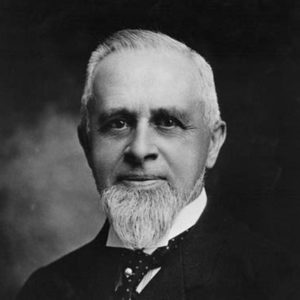 A Perhaps more than any other man, he contributed to the success of woodworking machinery, having invented more than 100 devices for the industry. For his contributions, he was decorated with the Cross of the Legion of Honor by the government of France in 1889. He was a devoted Baptist, and a musician of great ability, who wrote thousands of hymns, compiling more than 30 hymn books.
A Perhaps more than any other man, he contributed to the success of woodworking machinery, having invented more than 100 devices for the industry. For his contributions, he was decorated with the Cross of the Legion of Honor by the government of France in 1889. He was a devoted Baptist, and a musician of great ability, who wrote thousands of hymns, compiling more than 30 hymn books.
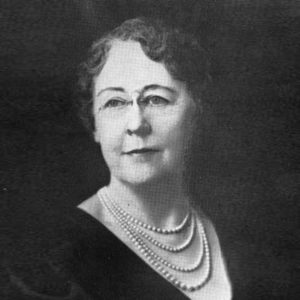
B A crater on the moon is named after him, and an asteroid between Jupiter and Mars was given his name on his 88th birthday. This 40-year Denison trustee built his fortune on the development of the turret lathe for machining tools with great accuracy. He ultimately held six honorary degrees and titles including Fellow of the Royal Astronomical Society and Officer of the French Legion of Honor. Very impressive, as was his head of hair, and his highly-visible legacies to the Denison campus.

C The originator of the Denison Art Treasure Collection in 1943 was president of a number of real estate, mortgage, and construction firms in the New York City area. His bequest to Denison of $1.25 million at his death in 1966 was for many years the largest single gift in the college’s history. What was built with this endowment?
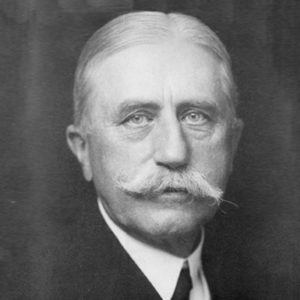 D This generous Denison benefactor built the same costly memorial to his father…twice.
D This generous Denison benefactor built the same costly memorial to his father…twice.
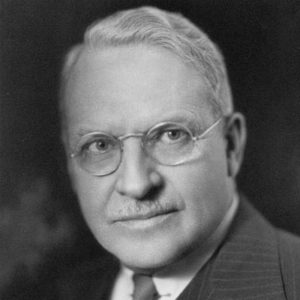 E This benefactor got no farther in his education than grade school, and in 1892, at age 18, he borrowed money from his uncle to buy the Osborn Manufacturing Co., where wooden-backed wire brushes were hand-made by two men, two girls, and three boys. By the time of WWII, machinery increased Osborn’s production beyond the rest of the industry combined. On his 95th birthday, he told the Cleveland Plain Dealer, “Instead of giving me a tin whistle, [Osborn Manufacturing] decided to give another $1,000 to the scholarship fund at Denison University. I suppose if I have any hobby, it’s Denison University.”
E This benefactor got no farther in his education than grade school, and in 1892, at age 18, he borrowed money from his uncle to buy the Osborn Manufacturing Co., where wooden-backed wire brushes were hand-made by two men, two girls, and three boys. By the time of WWII, machinery increased Osborn’s production beyond the rest of the industry combined. On his 95th birthday, he told the Cleveland Plain Dealer, “Instead of giving me a tin whistle, [Osborn Manufacturing] decided to give another $1,000 to the scholarship fund at Denison University. I suppose if I have any hobby, it’s Denison University.”
 F This Lady Bountiful of Denison’s Beta Theta Pi chapter (she funded most of the Beta house’s construction in the 1920s) knew Orville Wright and was the first female passenger to fly from Dayton to Columbus, in her private tri-motored plane, the “Kingbord.” Her son named an East Quad dormitory in her honor in 1953, but he removed her name from the building in 1971 when the college decided to convert the women’s residence to men’s housing. Mother may not have approved.
F This Lady Bountiful of Denison’s Beta Theta Pi chapter (she funded most of the Beta house’s construction in the 1920s) knew Orville Wright and was the first female passenger to fly from Dayton to Columbus, in her private tri-motored plane, the “Kingbord.” Her son named an East Quad dormitory in her honor in 1953, but he removed her name from the building in 1971 when the college decided to convert the women’s residence to men’s housing. Mother may not have approved.
The People
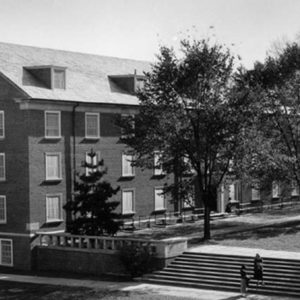 1 Edith Walton deeds of Dayton was a great supporter of the Betas, her husband Edward ’97 (a.k.a. “the Colonel”) having been a member, as well as her son, Charles ’23. In 1917, the Colonel purchased and gifted most of the East Quad’s land to Denison, and it was exclusively women’s housing for many decades. Son Charles built Edith W. Deeds Hall in 1953 as a near replica of Shaw Hall. Her name and portrait hung there for nearly 20 years, but it has been known as East Hall for the past 36 years.
1 Edith Walton deeds of Dayton was a great supporter of the Betas, her husband Edward ’97 (a.k.a. “the Colonel”) having been a member, as well as her son, Charles ’23. In 1917, the Colonel purchased and gifted most of the East Quad’s land to Denison, and it was exclusively women’s housing for many decades. Son Charles built Edith W. Deeds Hall in 1953 as a near replica of Shaw Hall. Her name and portrait hung there for nearly 20 years, but it has been known as East Hall for the past 36 years.
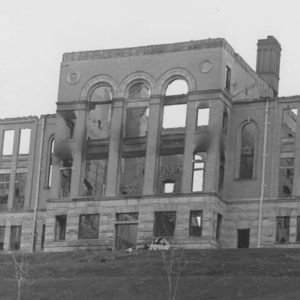 2 Eugene J. Barney, a Dayton trustee (1881-1917) first built “Science Hall” in 1894 for $45,000. The building and its valuable scientific equipment, library, and collections were destroyed by a fire 11 years later. It had only been insured for $37,000, and the actual loss was estimated at $100,000. Barney paid for the reconstruction in honor of his father, Eliam E. Barney, also a trustee and founder of a Dayton railroad car manufacturing company. The building was renamed Barney-Davis Hall in 1996 following a generous gift from the Samuel B. Davis family, and repurposed to house the Environmental Studies and English departments.
2 Eugene J. Barney, a Dayton trustee (1881-1917) first built “Science Hall” in 1894 for $45,000. The building and its valuable scientific equipment, library, and collections were destroyed by a fire 11 years later. It had only been insured for $37,000, and the actual loss was estimated at $100,000. Barney paid for the reconstruction in honor of his father, Eliam E. Barney, also a trustee and founder of a Dayton railroad car manufacturing company. The building was renamed Barney-Davis Hall in 1996 following a generous gift from the Samuel B. Davis family, and repurposed to house the Environmental Studies and English departments.
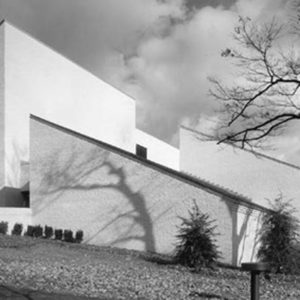 3 Burke Hall was the final expression of the gift from philanthropist and Denison trustee Edmund Glenn burke. Built of white synthetic stone and slate in 1973, it was designed in the New Brutalism style of totally abstract architecture. The project was first envisioned as a much larger facility, but even after its downscaling, Burke Hall included “the necessary rooms for the teaching of drama, music, painting and recital hall or theatre, as well as suitable facilities for the exhibition of works of art.” Burke donated a considerable collection of art works to the college as well, and believed that art is an integral part of a liberal arts education.
3 Burke Hall was the final expression of the gift from philanthropist and Denison trustee Edmund Glenn burke. Built of white synthetic stone and slate in 1973, it was designed in the New Brutalism style of totally abstract architecture. The project was first envisioned as a much larger facility, but even after its downscaling, Burke Hall included “the necessary rooms for the teaching of drama, music, painting and recital hall or theatre, as well as suitable facilities for the exhibition of works of art.” Burke donated a considerable collection of art works to the college as well, and believed that art is an integral part of a liberal arts education.
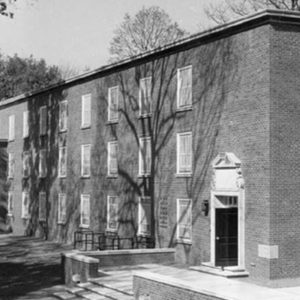
4 Franklin G. smith donated the aptly-named Smith Hall. Originally a men’s dormitory in 1953, it now provides coed student housing, and also accommodates the Black Student Union Lounge on its ground floor. Franklin Smith was the first trustee in Denison’s history to serve for half a century (1915-1968). After his brush manufacturing business became a success, he started another enterprise: a factory which was soon leading the world in the design and building of foundry molding machines. Later, the Cleveland industrialist also became president of the Ohio Rubber Company, which manufactured kayaks, landing boats, and tracks for military tanks.
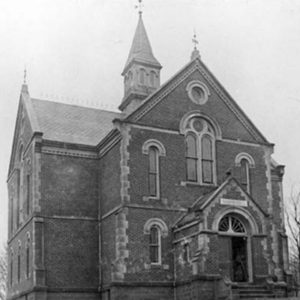 5 William Howard Doane built Denison’s first library, Doane Hall, which stood for almost 60 years before being outgrown and razed in favor of the present Doane Library, funded by his daughters Marguerite and Ida Doane. The two daughters also gave Denison the Life Science Building in 1941 (now called Higley Hall). Doane also built Doane Academy (now Doane Administration) and Doane Gymnasium for women (now Doane Dance).
5 William Howard Doane built Denison’s first library, Doane Hall, which stood for almost 60 years before being outgrown and razed in favor of the present Doane Library, funded by his daughters Marguerite and Ida Doane. The two daughters also gave Denison the Life Science Building in 1941 (now called Higley Hall). Doane also built Doane Academy (now Doane Administration) and Doane Gymnasium for women (now Doane Dance).
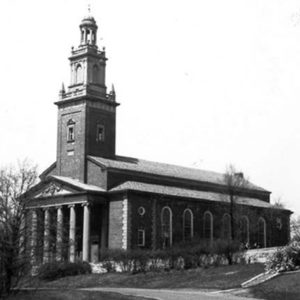 6 Ambrose Swasey funded the the first building in the ambitious “Greater Denison” plan of 1917, Sw asey Chapel, as well as Chapel Walk. It leads not only to the chapel but also to Swasey Observatory, an earlier gift from him, in 1909. Swasey outfitted the observatory with telescopes manufactured by his own Warner and Swasey Company of Cleveland, which produced astronomical instruments for many of the world’s finest and largest telescopes. Swasey’s close connection with science, however, never shook his faith in religion.
6 Ambrose Swasey funded the the first building in the ambitious “Greater Denison” plan of 1917, Sw asey Chapel, as well as Chapel Walk. It leads not only to the chapel but also to Swasey Observatory, an earlier gift from him, in 1909. Swasey outfitted the observatory with telescopes manufactured by his own Warner and Swasey Company of Cleveland, which produced astronomical instruments for many of the world’s finest and largest telescopes. Swasey’s close connection with science, however, never shook his faith in religion.

